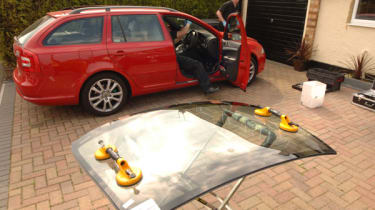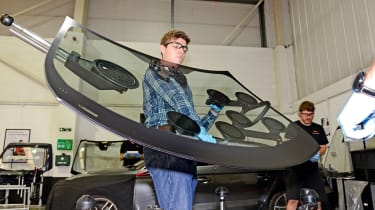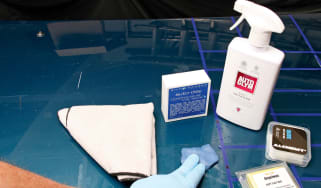Guide to car windscreen repair and car window replacement
What to do if you get a stone chip or crack in your car windscreen

It is a huge annoyance when you get a stone chip in your windscreen, and if it’s right in your line of sight when driving, it becomes infinitely more vexxing. Even if your screen survives the chip and doesn’t crack, there is still the possibility that the damage will cause your car to fail its next MoT, especially if it is in a critical area such as in front of the driver. In short,it is worth fixing stone chips and other windscreen damage sooner rather than later.
The MoT rules say that any windscreen damage with a diameter greater than 10mm, in a 290mm wide zone directly in front of the driver will result in an immediate failure. For the remaining area of windscreen which the wipers sweep, any damage with a diameter larger than 40mm will automatically fail your car as well.
That being said, should a chip occur outside these critical areas, don’t put off repairing the windscreen as the longer you wait to repair it, the worse it could get and the more it will cost to sort out. Simple stone chips are relatively inexpensive compared to replacing an entire slab of windscreen glass designed specifically for your car.
riving with a small stone chip in your car’s windscreen should not cause undue safety concerns. In theory, a chip could spread rapidly and shatter your windscreen, but in reality windscreen experts Auto Glass say this is an incredibly unlikely scenario. The laminated design of modern car windscreen glass – windscreens are typically constructed from two layers of glass sandwiched either side of a sheet of vinyl – is incredibly resilient.

What can happen though, is that moisture can seep inside a crack and cause localized delamination and discolouring, effectively extending the area of damage. Shocks from vibration, or even extremes of temperature can cause stone chips to extend into areas of localised crazing too. Again, while neither of these scenarios are immediately dangerous – unless your vision is significantly obstructed – you will need a new replacement windscreen as a chip repair kit won’t be able to deal with it.
• How to demist your car windows
How to repair a chipped windscreen
You can repair a windscreen yourself using a DIY resin kit, but many drivers with comprehensive insurance cover won’t have to bother. Insurers are generally delighted to cover the relatively small charge for a commercial repairer to spruce up your screen, as it often means they won’t be faced with a much bigger bill for a replacement windscreen.
You can find a windscreen repairer online, but you’re just as likely to find somebody offering insurer-approved repairs in the car park while you shop at your local superstore. Best of all, you generally only have to give the repairer your insurance company details, and they'll invoice the insurer direct on your behalf.
• Tyre pressures and tread depths explained
There is a downside, of course, which is that the warranty on screen repairs is virtually non-existent, and if it doesn’t work you could still be in line for a windscreen replacement. If you’re not covered on insurance, or have a big windscreen excess, this is the risk you take. Don’t expect your repairer to do anything other than point to their disclaimer.
DIY windscreen repair kits

If your windscreen isn’t covered on insurance, and if you’re confident with general DIY, you can save money repairing your windscreen with a kit bought from a car accessory shop. The kits are cheap and include a syringe and resin to force into the crack in your glass. We’ve heard good reports from people who have used the kits successfully, but of course you do need to follow the instructions to the letter – and be prepared to put it down to experience if the repair doesn’t work out.
How to replace a car windscreen
We paid a visit to Autoglass to try out some of their patented windscreen-fitting tech and had a go at changing a screen. Staff from the firm did the preparation, ensuring the car’s exterior and interior were protected and removing the car’s windscreen wipers.

The windscreen fitter's toolbox consists mainly of sophisticated clamps and lifting devices. A clever cutting tool – similar in appearance to a large fishing reel – is used to garrote the glue holding the screen in place and break it free. Most impressive is the ‘1-Tek’ that allows one technician to lift and manoeuvre a windscreen that would normally require two people.
We were amazed by just how heavy the screen was, but we were shown the correct technique to use and were eventually able to do the job without assistance.
The screen had to be cleaned before being lowered into place with new glue. Great care has to be taken to line it up correctly, but this is no problem if you use the correct technique. We were even told that our windscreen fitting was “a good job for a first attempt”.
Get more great car tips and expert advice here...








